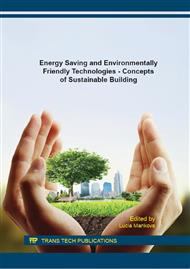p.210
p.218
p.226
p.235
p.243
p.251
p.259
p.267
p.278
Movement of CO2 Concentration in the Room
Abstract:
CO2 concentration in rooms, where we spend most of our lives, has become a problem that is solved by ventilation. In buildings, where is the ventilation additionally implemented, has become a problem with distribution systems. Between professionals is solved system so called “Cascade ventilation”, where is enough to incriminated room was at the junction of the inlet and exhaust air. If this assumption will be confirmed, it will facilitate the management of air distribution systems, especially in the case of renovations. Therefore would be no implementation of ceilings, which constitute a considerable part of the budget. Cascade system is based on the principle of Dalton's Law of partial pressures. For test of this theory has been used room, where is located 8 CO2 sensors. Here was monitored the movement of CO2 concentration from resources (human) and its distribution through the room in horizontal and vertical direction. The experiment was also simplified simulated in a computer program ANSYS Fluent and simulation results are compared with measured values.
Info:
Periodical:
Pages:
243-250
Citation:
Online since:
January 2016
Authors:
Keywords:
Price:
Сopyright:
© 2016 Trans Tech Publications Ltd. All Rights Reserved
Share:
Citation:


